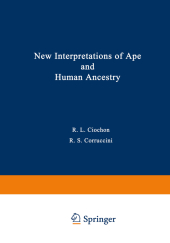 Neuerscheinungen 2013Stand: 2020-01-07 |
Schnellsuche
ISBN/Stichwort/Autor
|
Herderstraße 10
10625 Berlin
Tel.: 030 315 714 16
Fax 030 315 714 14
info@buchspektrum.de |

Russell Ciochon
New Interpretations of Ape and Human Ancestry
Herausgegeben von Ciochon, Russell
Softcover reprint of the original 1st ed. 1983. 2013. xxiv, 888 S. 291 SW-Abb. 244 mm
Verlag/Jahr: SPRINGER, BERLIN 2013
ISBN: 1-468-48856-2 (1468488562)
Neue ISBN: 978-1-468-48856-2 (9781468488562)
Preis und Lieferzeit: Bitte klicken
In the field of paleoanthropology there is perhaps no more compelling issue than the origin of the human lineage. From the 19th-Century proclamations of Darwin, Huxley, and Haeckel up to the present-day announcements of authorities such as Pilbeam, Johanson, and Leakey, controversy and debate have always surrounded the search for our earliest ancestors. Most authorities now agree that many important questions concerning ape and human ances try will be solved by further investigation of the hominoid primates of the Miocene and Pliocene, and through exacting comparative anatomical and biomolecular analyses of their living representatives. Indeed, these studies will yield a better understanding of (1) the cladogenesis (branching order) of the hominoid primates, (2) the morphotype (structural components) of the last common ancestor of humans and the living apes, (3) the timing and geographical placement of the hominid-pongid (human-ape) divergence and (4) the adaptive nature and probable scenario for the initial differentiation of hominids from pongids. In this context we organized a symposium entitled "Miocene Hominoids and New Interpretations of Ape and Human Ancestry" which met July 2-4, 1980, in Florence, Italy,just prior to the convening of the VIII Congress ofthe International Primatological Society. This Pre-Congress Symposium was at tended by a small group of anthropologists, anatomists, biochemists, ecolo gists, and paleontologists, all dedicated to a reanalysis of the evolutionary position and a more parsimonious interpretation of the Miocene hominoids vis a vis modern apes and humans.


